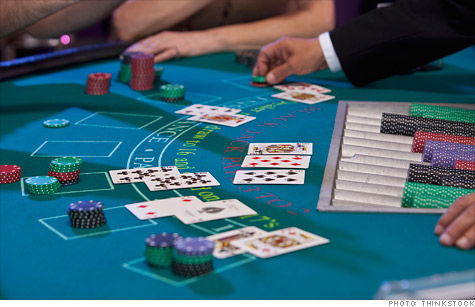
Sometimes hedging against a potential crisis can actually cause investors to double down on risk.
NEW YORK (CNNMoney) -- Since the financial crisis, Wall Street and investors have been enamored with creating the perfect hedge to protect portfolios against another market crash.
The problem with hedging, as illustrated by JPMorgan Chase's recent $2 billion (and growing) trading blunder, is that not everyone is very good at it.
JPMorgan's (JPM, Fortune 500) debacle also highlighted the fact that not everyone defines hedging in the same way.
Since the financial crisis, hedge funds and major investment banks have come up with increasingly sophisticated trades that could protect investors from so-called tail risk, or swift surprising downward moves in equities, bonds, commodities or currencies.
Despite a host of new tail risk hedging products, experts say that, overall, individual 401(k)s, pension plans and banks are no more protected than before this hedging strategy was trendy.
Ken Heinz, president of Hedge Fund Research, estimates that only between 15 and 25 hedge funds sell some version of a tail risk protection strategy.
A big reason why more funds aren't using this strategy is simple: it's costly. To get the greatest benefit from tail risk hedging, experts say investors would need to allocate 1% to 2% of their portfolio to the strategy.
"Given the current cost of hedging, if nothing happens, you bleed and bleed to death," said John Liu, the chief investment officer at the fund Spartus Capital.
"If something does happen, there's some protection but not nearly as much as you thought because it costs so much," added Liu, who ran Citigroup's (C, Fortune 500) tail risk hedging activities until mid 2011.
That's precisely the problem. Firms should expect to lose money in all instances except a market crash or sharp correction. For pension funds promising returns of 7% to 8% a year in a low-interest rate environment, that means allocating about 1% of a portfolio to a strategy that is expected to lose money.
Investors only get one chance to make big money with the right tail risk hedge, and that's in a crash. But investor patience can often wear thin, with many giving up the strategy just before that happens.
Universa, a $6 billion hedge fund that's been offering tail risk hedges since 2007, served investors well during the financial crisis. The fund generated more than a tenfold return on investment in 2008, when the S&P 500 (SPX) slumped nearly 39%.
The cost of hedging for extreme downside protection has spiked since then, said David Hait, President OptionMetrics, an options research firm.
The price of options that pay out when the market drops by more than 20%, known as "far out of the money puts," now cost significantly more than options that do the reverse, said Hait.
Other hedge funds, including Saba Capital and Pine River Capital, along with many banks have been developing tail risk protection products, but overall a small number of investors are covered, because of the cost.
Just this week, Universa launched two black swan exchange traded funds that track the S&P 500 and add crash protection through options. But its fees are significantly higher than other traditional ETFs.
Even if you remove the high cost, tail risk hedging can be a dicey proposition.
Hedging carries a host of other risks, like a Lehman-like bankruptcy by a counterparty leaving the fund holding the bag, according to Roy Smith, a professor of finance at New York University and a former managing director at Goldman Sachs (GS, Fortune 500).
Indeed, Smith's colleague at NYU, finance professor Stephen Brown studied investors who try to hedge themselves through a so-called fund of funds that invests in a multitude of hedge funds with different strategies.
While this isn't explicitly designed for tail risk hedging, investors often expect to see better returns in times of crisis by putting money into a mix of hedge funds. Not so, says Brown. During market corrections, those fund of funds performed worse than individual funds.
"Diversification alone is no protection against tail risk," said Brown. "In a tail risk event, we all fall down together."
That's precisely why investors all over the globe are growing increasingly jittery about how quickly problems in Europe can reverberate through the world. ![]()
| Index | Last | Change | % Change |
|---|---|---|---|
| Dow | 32,627.97 | -234.33 | -0.71% |
| Nasdaq | 13,215.24 | 99.07 | 0.76% |
| S&P 500 | 3,913.10 | -2.36 | -0.06% |
| Treasuries | 1.73 | 0.00 | 0.12% |
| Company | Price | Change | % Change |
|---|---|---|---|
| Ford Motor Co | 8.29 | 0.05 | 0.61% |
| Advanced Micro Devic... | 54.59 | 0.70 | 1.30% |
| Cisco Systems Inc | 47.49 | -2.44 | -4.89% |
| General Electric Co | 13.00 | -0.16 | -1.22% |
| Kraft Heinz Co | 27.84 | -2.20 | -7.32% |
| Overnight Avg Rate | Latest | Change | Last Week |
|---|---|---|---|
| 30 yr fixed | 3.80% | 3.88% | |
| 15 yr fixed | 3.20% | 3.23% | |
| 5/1 ARM | 3.84% | 3.88% | |
| 30 yr refi | 3.82% | 3.93% | |
| 15 yr refi | 3.20% | 3.23% |
Today's featured rates: